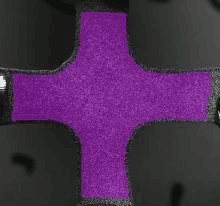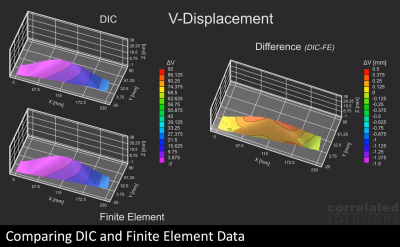DIC (Digital Image Correlation)

Digital image correlation is applied in solid mechanics, material research and development of mechanically loaded materials, components and structures. DIC contributes here especially due to the non contact and full field measurement of deformation and displacements and the derived quantities such as strain, vibration, motion and velocities for analysis of the mechanical properties. The results are use for validation of simulations.
The measurement results originate from the surface of the object itself recorded by stereo camera systems and evaluated with the VIC 2D or VIC 3D software of Correlated Solutions INC, USA. Within the solid it can be analysed by computer tomography systems (CT´s) and evaluated via the VIC Volume software. Correlated Solutions Europe is system integrator for VIC software in Europe and close development partner of Correlated Solutions INC, USA.
The resolution of the deformation and strain as well as its spatial and time resolution is depending on the system configuration. DIC system of Correlated Solutions Europe reach nanometer sensitivity as well as time resolution in nanosecond range. They have been applied on field of view below one mm² und above 100m², such as on rotating wind turbine blade with a diameter of 114m.

Application range of DIC for Strain and Deformation Measurement
DIC is applied for static and dynamic three dimensional strain and deformation measurement in the range of from 0,001% up to 1000% and above as well as for fatigue testing and monitoring. Using high resolution cameras with linear and low noise sensor properties a high spatial resolution can be achieved, too. Time resolution is actually possible up to 5 million frames per second.
DIC enables a measurement, which have not been possible with conventional methods such as at high temperatures, at high strains or on small field of view with high spatial resolution. In a number of cases DIC has replaced conventional methods such as strain gauges or extensometers – especially in the area of development and research due to the full field and non contact working principle.
Due to its advantages and due to the improved cameras and increasing computation power the digital image correlation systems have driven conventional optical methods for strain and deformation such as photoelasticity and electronic speckle pattern interferometry out of the market to a wide extend.

Application: Vibration Analysis of operation deflection mode shapes
in full field 3D is possible using high speed recording and applying the phase separation method (FFT-module extension of VIC Software). The application of the phase resonance methods in combination with e. g. elektrodynamic shakers or piezoshakers is possible using high resolution slow speed systems in combination with a phase synchronised camera triggering using the Videostroboscope principle as described above.











